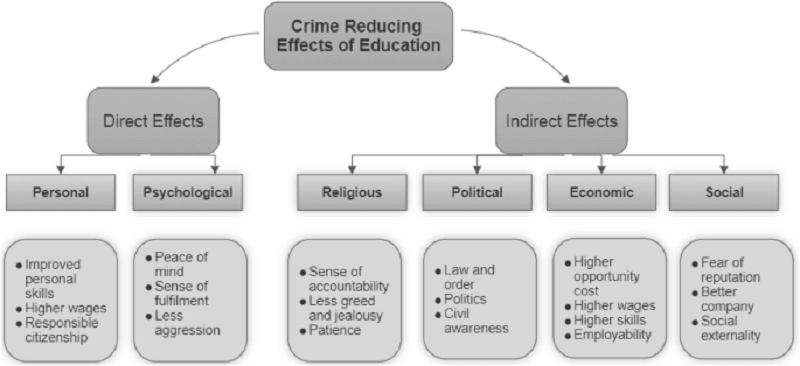A guest post written by Johnnie Mercurio.
Educators and criminologists have long postulated that increasing the educational attainment of young males may reduce the chances of them participating in crimes. There are many theories to predict the relationship between crime and education. First, education increases the economic returns to legitimate work. Second, education may directly increase the psychological burden of committing a crime. Finally, education can alter desires in indirect ways. For example, education may help youth better understand the consequences of their decisions, which may make them less criminally-minded.
Despite the theoretical reasons to believe that increasing high school graduation rates may result in lower crime rates, real life is more complicated. Estimating the effect of education on criminal activity is not that easy. Many unobserved factors may affect a students’ personality and decisions, causing them to commit a crime or at least increase the chances of them doing so. For example, teens who suffer any sort of abuse which may cause them psychological traumas are more likely to engage in criminal activities.
The Correlation Between Education and Crime
Research shows that achieving a college degree decreases crime rates across the world. Specifically, males’ higher college graduation rates have a stronger impact on crime reduction in comparison to that of female graduation rates. An increase in educational attainment can reduce the rate of violent crime through its influence on salaries. This correlation is supported by facts. For instance, female college graduates earn around $20,000, and male college graduates earn $25,800 more than their high school graduate counterparts. Such a perspective in growth can easily decrease one’s likelihood of committing a violent act or crime.
Schooling can also affect individual opinion about crime as it provides better awareness of the law, ethics, and morals. Many students go to school after facing or witnessing violent behavior at home. Home is the first point of departure for education, and school is an arena where students show their behavioral habits. The teacher’s role is to heal and start spreading awareness, implanting values and cultures, promoting positive trends, and adopting an approach to modify behavior. Not all teachers have the patience. Thus not all students find who may preach, advise, or even support them.
Time spent in education plays a huge role in the equation. Students spend approximately eight hours at school, five days a week. School attendance may have a strong effect on criminal participation. Besides that, they spend more time at home studying and doing their homework. Exams and other assignments like essays take much of their time also. Education keeps the teens occupied all the time in some way or another, engaging their minds in different issues away from violence.

The increase in students’ attainment should cause a decrease in their future probability of engaging in crime. Preferences are a mixture of hereditary and environmental factors, that is the basic nature of human beings. Schools must surely have a major influence, if only because they occupy a large part of the children’s day.
Despite all the theories about how schooling should reduce crime rates, the fact that some major crimes are committed by highly educated individuals is still there. Recently, some crimes even happen at schools. This means that keeping children off the streets or occuping their time is not enough to solve the problem.
One of the negative phenomena accompanying the educational system in schools around the world is violence, at least verbal or moral, if not physical. Almost no school is free of violence; whether it is between the students themselves or between students and teachers, it is still violence. It has crossed all limits, to the extent that we are now used to hearing about violent incidents that have taken place in schools. There will be underlying causes for this violence and there are options for treatment to address it. Let us take a deeper look at the main reasons that violence may develop in school kids.
Causes Of School Violence
Schools are not separate from society, rather school is a smaller society in itself. Every day, the students learn new things, and every day they find themselves in conflict and dichotomy between what they face at school and what is happening in the wider society around them. Teachers have an important role in treating school violence, and the following shows some things that could contribute to this:
Expanding the teacher’s responsibility outside the classroom:
Some teachers feel that their responsibility is limited to what is happening inside the classroom. They do not try to make themselves aware of what is happening outside of it. Teachers’ time is limited with a heavy workload and large class sizes to deal with day to day. However, this behavior may contribute to school violence, especially if problems that do arise among students are not addressed. Expanding responsibility through activities like monitoring the halls and following up on the movement of students and their words with each other can have a positive and preventative effect. This helps in getting to know more about the students’ characteristics, and the necessity to intervene if a student is insulted or beaten by another student or even another teacher.
Preventing inappropriate talk:
Students must be notified from the beginning of the school year about inappropriate talk and language. Make it clear to them that a classroom is a safe place for them, for their ideas, and discussions but this needs to be in an appropriate manner. They must be encouraged to acquire good behaviors and practice them together.

Knowing the Warning Signs:
There are many warning signs that indicate the possibility of behavior transformation into aggression and violence, and these behaviors may be the result of a defect in the family’s performance of its educational function. Therefore, these behaviors must be examined and followed up. Warning signs can include a student’s obsession with violent games, violence against animals, an exaggerated interest in violent weapons, and bringing them into school. The lack of remorse after a disagreement with peers, in addition to the student’s inability to manage his/her anger and mood swings are also red flags. The tendency to write things related to his/her feelings of hopelessness, isolation, or anger should be picked up on.
Discussing Violence And Crime Prevention With Students:
Violence can be discussed as an important topic in classrooms. Talking with students about the dangers and directing them to more appropriate behavior. Schools can organize extracurricular activities to help students on ways to deal with violence if they encounter it, whether at home, at school, or in the community. Teachers should build students’ confidence in them. Provide them with opportunities to talk about their concerns about violence and to listen to their questions and discussions openly. Communication between the teacher and students contributes to preventing violence.
Teaching Students Conflict Resolution And Anger Management Skills:
The teacher can use appropriate opportunities to teach students how to solve conflicts among themselves and solve their problems without resorting to violence. Classroom discussions can be organized to talk about those skills, and the teacher can teach students ways to manage their anger in a healthy and appropriate way.
School Programs
Setting up school programs specifically to treat and prevent violence when warning signs have appeared. Identifying students who show warning signs providing support and intervention early. Providing environments that support the development of children and protect them from the problems they may encounter. Overall, such programs can help to create a supportive environment for children that enhance their confidence and self-esteem.
Establishing and building societies with less crime and less violence will not happen without a better education. There are important principles our children must learn. We need to focus more on that.
- Gonzalez, A. (Spring 2015) Education: The Secret to Crime Reduction. Thesis Draft, International Relations Honors, New York University.
- Britannica. Characteristics of Offenders. Crime and Law.
- iResearchnet. Education and Crime: IV. Education’s Impact on Crime. Criminal Justice.
- Hjalmarsson, Randi & Lochner, Lance. (2012). The Impact of Education on Crime: International Evidence. CESifo Dice Report, Journal for Institutional Comparisons. 10.
- Lochner, L., & Moretti, E. (2004). The Effect of Education on Crime: Evidence from Prison Inmates, Arrests, and Self-Reports. The American Economic Review, 94(1), 155-189.
- Aslund, Olof and Gronqvist, Hans and Hall, Caroline and Vlachos, Jonas. Education and Criminal Behavior: Insights from an Expansion of Upper Secondary School. IZA Discussion Paper No. 9374.
About the author: Johnnie Mercurio is a researcher and writer in criminology and criminal psychology, occasionally guest blogging for Edubirdie. He reads books and plays video games when he is not trying to learn something about everything.







![Are Narcissists Dangerous? The 9 Traits of a Narcissistic Personality [Infographic]](https://www.crimetraveller.org/wp-content/uploads/2016/05/narcissistic-100x70.jpg)


